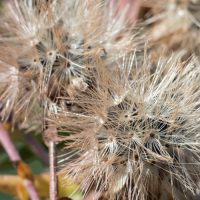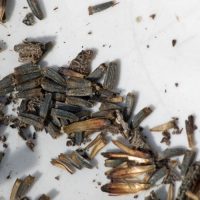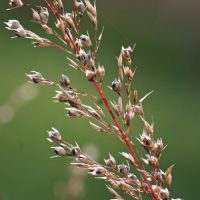By Dawn Weber
Board Member-at-Large, Wild Ones – St. Louis Chapter
The November gathering is almost here, and we want lots of participation in this year’s seed exchange. While you don’t need to bring seeds in order to take some home, more seeds means more sharing!
Never collected seeds from your garden before? Here’s how:
Where can I collect seed?
You must have permission to collect from private and public spaces, which can be complicated. Collecting in your own yard is easiest and best, as those are *your* plants, no permission required.
Are the seeds ready to be collected?
Is the plant dispersing the seeds on its own already? If so, it is ready for collection. Seed heads are ready when they’re brown and dried. Seed pods should start to split when you squeeze them.
All of the seed heads or pods on late-summer and fall-blooming plants may not be ready yet. Focus on the ones that are ready.
How do I collect the seeds?
Ironweed (Vernonia spp.), Coreopsis spp., and Liatris spp. seeds are easily collected. Others, like coneflowers, can be prickly as the seeds are the little bits between the spikes, where you need to break apart the seed head to get the seeds out. You can use pruners to remove the entire seed head or stem of the plant, in order to avoid uprooting the plant. Grass seeds are simple to collect by running your hand up the stem, bottom to top, gathering the seeds as you go.
Be sure to leave some seeds in place, as they are an important winter food source for finches, cardinals, sparrows, and other wildlife.
Wondering which part is the seed? Look up your plant at Prairie Moon Nursery where most seeds are pictured. If the exact species is not there, try something in the same genus (specis Echinacea purpurea vs genus Echinacea). They may be similar.
How do I dry and store the seeds?
Let the collected seeds dry out, from a few days to a week, in open paper bags or cardboard boxes. If you collect them after rain or other damp weather, they’ll need more time to dry. The seeds need airflow to ensure that they are dry, but keep them protected from direct wind (They could blow away.) and critters who may eat them.
When the seed heads and pods are dry enough, they will crumble between your hands. Break apart until all the seeds are released. Place seeds and chaff (the non-seed material) in a bowl or box and swirl or shake gently. Most of the larger chaff pieces will rise to the top and can simply be removed by hand.
Store in labeled paper bags or envelopes, in a dark cool, dry location. Avoid glass and plastic as they may promote growth of mold.
How do I package the seeds for the exchange?
Paper envelopes are best, labeled with
- The common name
- The scientific name
- The month/year collected
- Your name (the collector)
- The germination code, if you know it
For the 2024 Seed Exchange, plants that are not labeled with their scientific name OR are cultivars OR are not native will go into a separate area that will not be tended to by our helpful volunteers.
After the gathering we’ll have a follow-up post on methods of starting plants from seed.
Please share your seed gathering tips in the comment section below!






Thanks Dawn! Good advice.
One trick with milkweeds, once the seed pods have slightly cracked open, hold the feathery half down and rub the seed end between your fingers. The brown flat seeds will fall out. This stops the plumes of down from floating off. However, there is some fun in that.
Thanks for the information, Dawn.
In other news, it is time to begin ordering native trees seedlings from the Missouri Department of Conservation Tree Nursery.
You can order bundles of 10 or 25 of a species online at starting October 1st.
For those of you who would like to order less than 10 of any one species,
I will have a sign up sheet and online group order sheet ready for the November 2nd meeting.
Enjoy the fall colors and the last of the asters….
Thanks for the reminder about the seedling order! We will do a separate post and email to be sure that everyone has the opportunity to participate
Also, I added the information to the Announcement section of our homepage.
Thank you for this informative and timely blog post, Dawn.
Your article provides some great basic information for any gardener. The close-up photo of Wild Senna (Senna marilandica) shows the intricate detail in such a way as to inspire awe. Now, I need to store my seeds in paper envelopes instead of the glass jar I was using. 😉
Great article Dawn. I went out last week to collect some of my cone flowers and black eyed Susans only to discover that they had already “exploded.”
Coreopsis Is still going strong. Thank goodness I keep my bird feeders filled but I am looking for lots of new plants in that side garden!
Will check sooner next year.
I forgot one of my favorite tips! To gather seeds from plants whose seed pods “explode”, like jewelweed, or to try to keep the birds from eating them, use a drawstring organza bag, like you’d see as wedding favors, to go around the seed head until they are ripe enough to collect.
Another suggestion is to tie old pantyhose or other light mesh around the seed capsule with some thread or thin elastic band when they are almost dried.
Another helpful article: http://www.nanps.org/index.php/plant-sources/159-seed-collection-reaping-what-you-sow